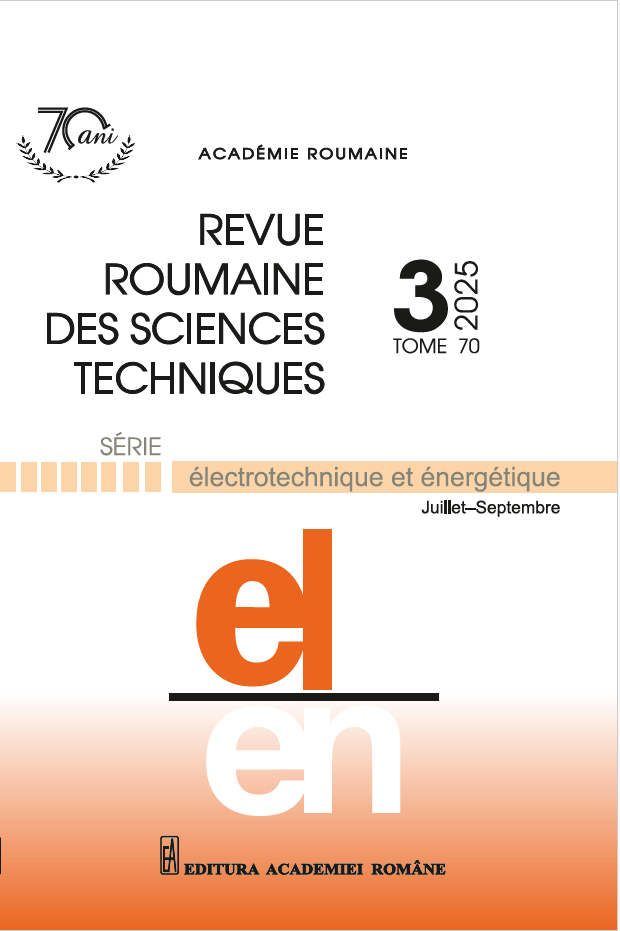CONVERTISSEUR BOOST À DEUX ÉCHELLES, TOLÉRANT AUX PANNES, CAPABLE ET ÉVOLUTIF, DESTINÉ AUX ZONES RÉSIDENTIELLES
DOI :
https://doi.org/10.59277/RRST-EE.2025.3.15Mots-clés :
Micro-réseaux, Échelle double, Tolérance aux pannes, Haute performance, Contrôle robuste, Systèmes de stockage électrique, Efficacité optimisée ; Convertisseur évolutifRésumé
La faisabilité des réseaux électriques urbains de nouvelle génération repose sur la capacité des convertisseurs CC à remplacer leurs homologues conventionnels. La fiabilité et l'efficacité sont des points très controversés face aux défis posés par la prolifération de l'électronique de puissance dans les systèmes électriques. Motivé par la recherche d'une solution efficace, cet article présente le paradigme du convertisseur à deux échelles de temps. L'utilisation d'une division de la dynamique, interprétée à partir de la théorie des perturbations singulières, permet d'obtenir une redondance rentable sous la forme de sous-systèmes rapides et lents complémentaires. Le convertisseur proposé peut ainsi gérer des perturbations considérables avec un temps de réponse rapide et assurer un fonctionnement rentable en régime permanent, grâce à la réduction de la fréquence de commutation. Le schéma de commande global comprend une boucle de régulation de courant interne et une boucle de régulation de tension externe ; les lois de commande sont dérivées d'une approche générique de Lyapunov, adaptable aux caractéristiques de la source de tension. Les résultats de simulation ont démontré une réponse transparente à divers types de perturbations et une gestion appropriée de différents scénarios de défauts d'omission.
Références
(1) V. Vossos, D. L. Gerber, M. Gaillet-Tournier, B. Nordman, R. Brown, W. Bernal Heredia, S. M. Frank, Adoption pathways for DC power distribution in buildings, Energies, 15, 3, pp. 786 (2022).
(2) D. Santoro, N. Delmonte, M. Simonazzi, A. Toscani, N. Rocchi, G. Sozzi, R. Menozzi, Local power distribution—A review of nanogrid architectures, control strategies, and converters, Sustainability, 15, 3, pp. 2759 (2023).
(3) M. Najafzadeh, R. Ahmadiahangar, O. Husev, I. Roasto, T. Jalakas, A. Blinov, Recent contributions, future prospects and limitations of interlinking converter control in hybrid AC/DC microgrids, IEEE Access, 9, pp. 7960–7984 (2021).
(4) S. Chellappan, J. Rangaraju, Power topology considerations for solar string inverters and energy storage systems, Texas Instruments, SLLA498 – October (2020).
(5) D. Kolantla, S. Mikkili, S. R. Pendem, A. A. Desai, Critical review on various inverter topologies for PV system architectures, IET Renew. Power Gener., 14, no. –, pp. 3418–3438 (2020).
(6) A.C. Zambroni de Souza, M. Castilla, Microgrids design and implementation, Springer, ISBN: 978-3-319-986869 (2019).
(7) B. Hadmer, S. Drid, A. Kouzou, L. Chrifi-Alaoui, Voltage sensorless control of five-level packed U-cell inverter based on Lyapunov approach for grid-connected photovoltaic system, Rev. Roum. Sci. Techn. – Électrotechn. Et Énerg., 69, 2, pp. 135–140 (2024).
(8) S. Latreche, B. Babes, A. Bouafassa, Design and real-time implementation of synergetic regulator for a DC-DC boost converter, Rev. Roum. Sci. Techn. – Électrotechn. Et Énerg., 69, 3, pp. 305–310 (2024).
(9) R. Thankakan, N. A. Edward-Rajan-Samuel, A novel power converter fed by photovoltaic source employing improved incremental conductance algorithm under partial shadow conditions, Rev. Roum. Sci. Techn. – Électrotechn. Et Énerg., 67, 2, pp. 145–150 (2022).
(10) A. Benaissa, B. Rabhi, M.F. Benkhoris, L. Zellouma, Linear quadratic controller for two-interleaved boost converter associated with PEMFC emulator, Rev. Roum. Sci. Techn. – Électrotechn. Et Énerg., 66, 2, pp. 125–130 (2021).
(11) A.E. Ahmed, M. Zohdy, Sliding mode control for singularly perturbed systems using accurate reduced model, Int. J. Mod. Nonlinear Theory Appl., 10, 1, pp. 1 (2021).
(12) S. Hebertt, S. Ramón, Control design techniques in power electronics devices, Cinvestav-IPN, Departamento de Ingeniería Eléctrica, Sección de Mecatrónica, Power Systems Series, pp. 20–81 (2006).
(13) H. Sira-Ramírez, R. Silva-Ortigoza, Control design techniques in power electronics devices, Springer, 5, pp. 23–63 (2006).
(14) W. Li, J.-J. E. Slotine, Applied nonlinear control, Prentice-Hall, Inc., pp. 276–307, ISBN: 0-13-040890-5 (1990).
(15) J. Guldner, J. Shi, V. Utkin, Sliding mode control in electro-mechanical systems, Taylor & Francis, pp. 232 (1999).
(16) T. Sari, Singular perturbation methods in control theory, Mulhouse University, Nice University (2006).
(17) C. Gschwendtner, C. Knoeri, A. Stephan, The impact of plug-in behavior on the spatial–temporal flexibility of electric vehicle charging load, Sustainable Cities and Society, 88, pp. 104263 (2023).
(18) M.-D. Drid, S. Hamdani, A. Nait-Seghir, L. Chrifi-Alaoui, S. Labdai, S. Drid, Optimal energy management systems and voltage stabilization of renewable energy networks, Applied Sciences, 14, 21, pp. 1–22 (2024).
Téléchargements
Publiée
Numéro
Rubrique
Licence
(c) Copyright REVUE ROUMAINE DES SCIENCES TECHNIQUES — SÉRIE ÉLECTROTECHNIQUE ET ÉNERGÉTIQUE 2025

Ce travail est disponible sous licence Creative Commons Attribution - Pas d'Utilisation Commerciale - Pas de Modification 4.0 International.


